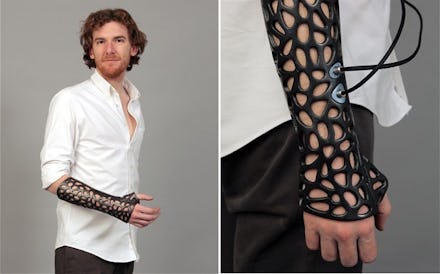This 3-D Printed Cast Will Revolutionize How We Mend Our Broken Bones

The news: 3-D printers are being used for everything from building low-cost homes to preparing fresh food and inking tattoos. Now you can add healing bones to the list.
Meet the Osteoid, a medical cast and bone stimulator that relies on ultrasonic vibrations to speed up the process of healing bones. While the idea of vibrational therapy is not new, 3-D printing can allow doctors and technicians to create casts with a perfect, custom fit, which can be placed directly on the patient's skin.
The cast will allow low-intensity, pulsed ultrasound bone stimulation, which has been shown to speed up healing.
"For single 20-minute daily sessions, this system promises to reduce the healing process up to 38% and increase the heal rate up to 80% in nonunion fractures," said Deniz Karasahin, the industrial designer behind the prototype.
Other upsides: The ventilated design means you don't have to deal with the smell or the itching that is unavoidable with traditional casts, as the Osteoid will "improve the overall healing experience for broken or fractured limbs by focusing on the patient’s comfort and the amount of time needed for the body to heal itself." The cast will be slimmer and lighter than regular casts, will be environmentally friendly and water-resistant — but most importantly, will make you look like you're wearing cool alien tech.
Image Credit: DK Designs
What else can 3-D printing do? One of the most thrilling adaptations of 3-D printing technology is in the field of medicine. While the Osteoid is still a prototype, doctors and researchers are already using 3-D printing to similarly tailor medical devices and tools to the patient's body.
A 3-D heart model allowed doctors to figure out the best way to carry out surgery on a boy's heart, while a baby's life was saved after a medical engineer to create a custom-fit device to hold his windpipe open. A dad figured out how to print an affordable prosthetic for his son, while neurosurgeons in the Netherlands were able to implant a 3-D printed skull for a woman suffering from bone disease. Another printed heart model was used to create an electronic membrane that can keep a heart beating and serve as an emergency medical device — and this was all in the past year.
The possibilities are limitless. Researchers are already working on incorporating 3-D technology to create skin, ears, noses, eyes, bones, blood vessels and cells.
Due to the customizable nature of 3-D printing, this technology can be used in nearly every facet of medicine, in ways that we might not even be able to conceive of now. Devices like the Osteoid, as cool and promising as they may be, are just the beginning.